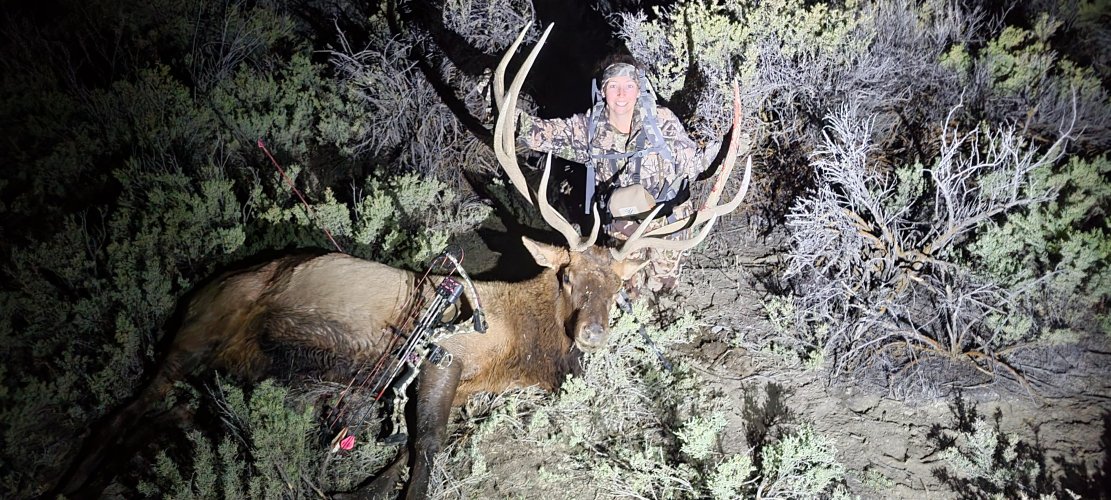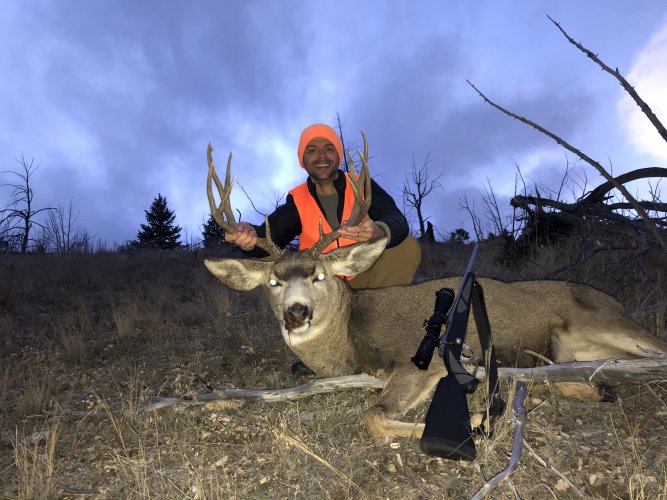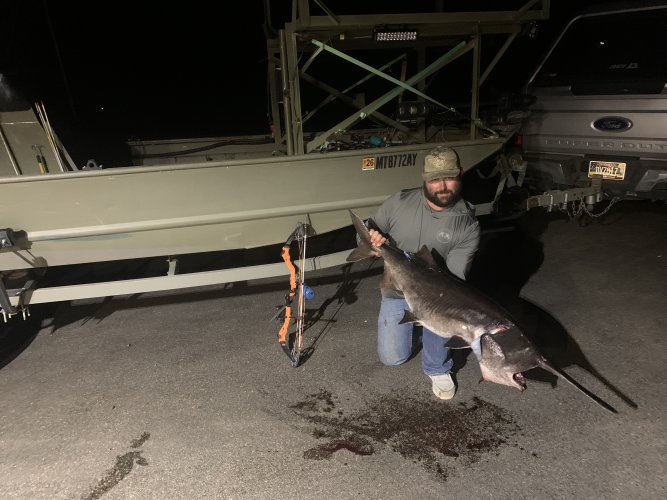Navigation
Install the app
How to install the app on iOS
Follow along with the video below to see how to install our site as a web app on your home screen.
Note: This feature may not be available in some browsers.
More options
You are using an out of date browser. It may not display this or other websites correctly.
You should upgrade or use an alternative browser.
You should upgrade or use an alternative browser.
How Old Was that Animal?
- Thread starter Big Fin
- Start date
antlerradar
Well-known member
Rapid growth, yes, but it is that last 10 to 15 % that separates the ones you put on the wall of the living room from the ones you hang in the rafters of the garageIf you want to really dig into some dry reading check this one out...
or check out page 31 of Utah's statewide management plan, https://wildlife.utah.gov/public_meetings/rac_minutes/2022-11-elk-management-plan.pdf
essentially growth is rapid to 6.5 in elk, 4.5 in mule deer, then slows considerably...
GrantK
Well-known member
I think one of the interesting things from those studies is overall the smaller-than-expected average size, at least based off of what most people consider a "big" elk... there was a lot of elk measured and the average max score, regardless of age, was 321, most of the record book-sized animals are a genetic/conditions anomaly that even at quite young ages would be much more than 10% larger than an average animal of a similar age...
Big Sky Guy
Well-known member
- Joined
- Dec 10, 2018
- Messages
- 814
I do not have any data to say otherwise. All I can say is there have been numerous “trophy” class elk come through in their double digits. A 12 year old 410” and 11 year old 350” bull come to mind. I do not know how old they were when they are six.View attachment 275446
Thoughts on this? I’d say there is way more contradictory info out there but I’m also not an influencer with 70 thousand followers
The Steve Felix bull was 6, which scored 429”. Seems to at least be a seed for this theory.
I’ve often wondered if the Felix bull would have been 450” at 8 or 10, or if those double digit bulls would have been bigger several years earlier.
BuzzH
Well-known member
They peak at 4 because essentially none make it to 5.Montana fwp has told me deer peak at 4 years old. They are wrong.
Big Sky Guy
Well-known member
- Joined
- Dec 10, 2018
- Messages
- 814
5 year old Montana mule deer. Biggest deer I’ve seen on the hoof since 2017.They peak at 4 because essentially none make it to 5.
Attachments
Big Sky Guy
Well-known member
- Joined
- Dec 10, 2018
- Messages
- 814
I had to use a ratchet strap to get them tight enough.I’m guessing your boots were laced up so tight you couldn’t feel your feet.
Eric Albus
Well-known member
- Joined
- May 24, 2012
- Messages
- 1,792
Aged by cross section of the tooth, or by gauging tooth wear?5 year old Montana mule deer. Biggest deer I’ve seen on the hoof since 2017.
Big Sky Guy
Well-known member
- Joined
- Dec 10, 2018
- Messages
- 814
Cross section analyzed under microscope. Processed here at Matson’s. (Hello btw, I met you at the elk management thing in Bozeman last year).Aged by cross section of the tooth, or by gauging tooth wear?
Eric Albus
Well-known member
- Joined
- May 24, 2012
- Messages
- 1,792
Here is what I’ve seen from a day or two of observing.Rapid growth, yes, but it is that last 10 to 15 % that separates the ones you put on the wall of the living room from the ones you hang in the rafters of the garage
Let’s say for arguments sake at 4 most buck mulies are a 160 average and wt a 140(this is what the vast majority are genetically predisposed to be.
A lot of bucks throw their best set of antlers at 4, very few make it past this age(hunting/predation/weather/bad luck/stupidity).
The fact it’s tough to get past 4 makes this the most sensible age to manage a population for. (I’m not sensible, in SE Mt I try to manage for 5.5, and it ain’t easy, plus it’s costly)
Now, as to the rest of the story, IF(big if) they live past 4, they can be make a jump in any given year if 25-50 inches, depending on if the stars align for them. I have sheds off a bucks that grew 35 inches in a yr, I also have sheds that shrunk 20 inches from 4-5, then at 6.5 put in 35-8 inches.
Antler growth has so many variables it’s unrealistic to hope to outguess and manage with any certainty. In order to have great numbers of big deer you need to have lots of old, old deer. We will most likely never see this again, as hunting pressure is to great, from 4&2 legged predators, cwd impacts.
antlerradar
Well-known member
agree with this. 140 is a bit generous for our whitetails, but the Milk is different.Here is what I’ve seen from a day or two of observing.
Let’s say for arguments sake at 4 most buck mulies are a 160 average and wt a 140(this is what the vast majority are genetically predisposed to be.
Probably true because most deer don't live much past 4. However the vast majority of the bucks I have followed that did live to double digits grew there best antlers much later in life.A lot of bucks throw their best set of antlers at 4, very few make it past this age(hunting/predation/weather/bad luck/stupidity).
I could only wish the average Montana buck saw his fourth birthday. You are the the exception, most of the managers of private I know shoot any buck that has antlers big enough no matter the age. Some talk a good game, but come up short in implementation. If I had sole control of managing I would try to let some of the bucks with the best potential live to old age, but I don't have expenses to pay and customers to keep happy.The fact it’s tough to get past 4 makes this the most sensible age to manage a population for. (I’m not sensible, in SE Mt I try to manage for 5.5, and it ain’t easy, plus it’s costly)
I too often see bucks drop in growth, The reasons are many. Most of the time they will recover past glory.Now, as to the rest of the story, IF(big if) they live past 4, they can be make a jump in any given year if 25-50 inches, depending on if the stars align for them. I have sheds off a bucks that grew 35 inches in a yr, I also have sheds that shrunk 20 inches from 4-5, then at 6.5 put in 35-8 inches.
Antler growth has so many variables it’s unrealistic to hope to outguess and manage with any certainty. In order to have great numbers of big deer you need to have lots of old, old deer. We will most likely never see this again, as hunting pressure is to great, from 4&2 legged predators, cwd impacts.
Any time you want to go through the antler collection and see the evidence, you are welcome Eric.
Eric Albus
Well-known member
- Joined
- May 24, 2012
- Messages
- 1,792
Agreed. I was being a bit generous on the wt average and md. 135 is what most wt get, most mulies 150-155. The exceptions are what some of us strive for.agree with this. 140 is a bit generous for our whitetails, but the Milk is different.
Probably true because most deer don't live much past 4. However the vast majority of the bucks I have followed that did live to double digits grew there best antlers much later in life.
I could only wish the average Montana buck saw his fourth birthday. You are the the exception, most of the managers of private I know shoot any buck that has antlers big enough no matter the age. Some talk a good game, but come up short in implementation. If I had sole control of managing I would try to let some of the bucks with the best potential live to old age, but I don't have expenses to pay and customers to keep happy.
I too often see bucks drop in growth, The reasons are many. Most of the time they will recover past glory.
Any time you want to go through the antler collection and see the evidence, you are welcome Eric.
The odds of living past 4.5 for a buck are long, even in an unhunted population.
I figure by attempting a 5.5
Yr av. on mule deer that I take some who were not gonna make it, and a few are smart enuf to escape to live a while longer.
Carnage2011
Well-known member
He’s the same guy that claimed the reason the ranch has no big bulls is because they have too many small ones so the big ones won’t come on there. I quote “if you kill all those raghorns the big bulls will show up.” He’s a special one…If bullshit were music, that guy would be John Phillip Sousa.
Those are great looking bulls.My son killed this bull in 2017. Matson's lab aged it at 5 years old. It was in an area where ag fields were available. I don't have an age on the bull on the left in the second picture.
View attachment 286226View attachment 286227
cgasner1
Well-known member
- Joined
- Apr 24, 2016
- Messages
- 4,872
Big Sky Guy
Well-known member
- Joined
- Dec 10, 2018
- Messages
- 814
Send us a tooth from the bull on the left and we can get an age for youMy son killed this bull in 2017. Matson's lab aged it at 5 years old. It was in an area where ag fields were available. I don't have an age on the bull on the left in the second picture.
View attachment 286226View attachment 286227
Was she tagged in MT or ND? My guess with that growth she’s 35-45. Would have been interesting to see how many schenes of roe she had in her earlier this spring.Don’t have a official age for it yet but it was banded in 1996 and had only grown 2” since being banded
seeth07
Well-known member
Forgot about this thread and it reminded me to go check Wyoming ages results as my wife was required to send a tooth in for her unit 100 bull. He was 5.5. Was also cool to see everyone else's results. Not many punched their tag in archery season, only 10 did. I told my wife she should feel pretty dang proud of that! Although we thought he was a pretty dang good bull, seeing the aging of what was harvested he was a young pup as lots of bulls in the 7.5 to 10.5 age range were taken.


Similar threads
- Replies
- 230
- Views
- 18K






